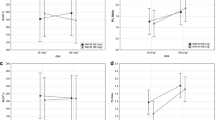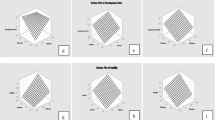Abstract
In this work, we evaluated the effects of nine commercial enzymes—fungal (AMY-F), bacterial (AMY-B), and maltogenic (AMY-M) α-amylases, fungal (XYL-F) and bacterial (XYL-B) xylanases, glucose oxidase (GOX), laccase (LAC), lipase (LIP), and transglutaminase (TG) on the rheological properties of common wheat flour. Falling Number (FN), farinography, and alveography analysess were carried out varying the enzyme concentrations from 25 to 833 U kg−1, aiming to reach baking quality. α-Amylases affected mainly the farinographic properties, reducing the water absorption (WA) and stability time (ST). AMY-B was the most effective enzyme to adjust the FN, needing 150 U kg−1, while for AMY-F and AMY-M, it was necessary 583 U kg−1. In all tests, XYL-B was more efficient than XYL-F, but both improved the W value and P/L ratio. At 25 U kg−1, GOX increased the development time (DT), as well as the ST and the P/L ratio. LAC, which is not a commonly used enzyme, significantly improved the ST and W values, being an interesting oxidant agent. Moreover, the ideal enzyme concentrations determined were compared with those suggested by the suppliers, with under and over dosages observed, especially for α-amylases and xylanases.

Similar content being viewed by others
References
AACC. (2000). Approved methods of analysis (10th ed.). St. Paul: American Association of Cereal Chemists.
AACC (2005) Mill Process Control. In: Wheat flour milling. References Series. p^pp 397–418. AACC International, Inc.
AACC. (2009). Approved methods of analysis (11th ed.). St. Paul: American Association of Cereal Chemists.
Ahmad, Z., Butt, M. S., Ahmed, A., & Khalid, N. (2013). Xylanolytic modification in wheat flour and its effect on dough rheological characteristics and bread quality attributes. Journal of the Korean Society for Applied Biological Chemistry., 56(6), 723–729.
Bailey, M. J., Biely, P., & Poutanen, K. (1992). Interlaboratory testing of methods for assay of xylanase activity. Journal of Biotechnology, 23(3), 257–270.
Barrera GN, León AE & Ribotta PD (2015) Use of enzymes to minimize the rheological dough problems caused by high levels of damaged starch in starch-gluten systems. Journal of the Science of Food and Agriculture. In Press, 10.1002/jsfa.7374.
Bataillon, M., Cardinali, A. P. N., Castillon, N., & Duchiron, F. (2000). Purification and characterization of a moderately thermostable xylanase from Bacillus sp strain SPS-0. Enzyme and Microbial Technology, 26(2–4), 187–192.
Bernfeld P (1955) Amylase, α and β. In: Methods in enzymology, vol 1. p^pp 149–158. Academic Press.
Bonet, A., Rosell, C. M., Caballero, P. A., Gómez, M., Pérez-Munuera, I., & Lluch, M. A. (2006). Glucose oxidase effect on dough rheology and bread quality: a study from macroscopic to molecular level. Food Chemistry, 99(2), 408–415.
Caballero, P. A., Bonet, A., Rosell, C. M., & Gomez, M. (2005). Effect of microbial transglutarninase on the rheological and thermal properties of insect damaged wheat flour. Journal of Cereal Science, 42(1), 93–100.
Caballero, P. A., Gómez, M., & Rosell, C. M. (2007). Improvement of dough rheology, bread quality and bread shelf-life by enzymes combination. Journal of Food Engineering, 81(1), 42–53.
Cauvain, S. P., & Young, L. S. (2006). The Chorleywood bread process. Boca Raton: CRC Press.
Cauvain, S. P., & Young, L. S. (2007). Technology of breadmaking (2nd ed., Vol. 1). New York: Springer.
Ciucu, A., & Patroescu, C. (1984). Fast spectrometric method of determining the activity of glucose oxidase. Analytical Letters, 17(12), 1417–1427.
Claus, H. (2004). Laccases: structure, reactions, distribution. Micron, 35(1–2), 93–96.
Collar, C., & Bollain, C. (2005). Impact of microbial transglutaminase on the staling behaviour of enzyme-supplemented pan breads. European Food Research and Technology, 221(3–4), 298–304.
Courtin, C. M., & Delcour, J. A. (2001). Relative activity of endoxylanases towards water-extractable and water-unextractable arabinoxylan. Journal of Cereal Science, 33(3), 301–312.
Csáki, K. F. (2011). Synthetic surfactant food additives can cause intestinal barrier dysfunction. Medical Hypotheses, 76(5), 676–681.
Degrand, L., Rakotozafy, L., & Nicolas, J. (2015). Activity of carbohydrate oxidases as influenced by wheat flour dough components. Food Chemistry, 181, 333–338.
Dunnewind, B., Van Vliet, T., & Orsel, R. (2002). Effect of oxidative enzymes on bulk rheological properties of wheat flour doughs. Journal of Cereal Science, 36(3), 357–366.
Figueroa-Espinoza, M. C., Poulsen, C., Soe, J. B., Zargahi, M. R., & Rouau, X. (2004). Enzymatic solubilization of arabinoxylans from native, extruded, and high-shear-treated rye bran by different endo-xylanases and other hydrolyzing enzymes. Journal of Agricultural and Food Chemistry, 52(13), 4240–4249.
Garcia, T. A. (2006). Purificação e caracterização das lacases de Pycnoporus sanguineus. Brasília: Doutorado em Biologia Molecular, Departamento de Biologia Celular, Universidade de Brasília-Instituto de Ciências Biológicas.
Gerits, L. R., Pareyt, B., Decamps, K., & Delcour, J. A. (2014a). Lipases and their functionality in the production of wheat-based food systems. CRF3 Comprehensive Reviews in Food Science and Food Safety, 13(5), 978–989.
Gerits, L. R., Pareyt, B., & Delcour, J. A. (2014b). A lipase based approach for studying the role of wheat lipids in bread making. Food Chemistry, 156, 190–196.
Goesaert H, Gebruers K, Courtin CM, Brijs K & Delcour JA (2007) Enzymes in Breadmaking. In: Bakery products: Science and Technology. p^pp 337–364.
Goesaert, H., Leman, P., Bijttebier, A., & Delcour, J. A. (2009a). Antifirming effects of starch degrading enzymes in bread crumb. Journal of Agricultural and Food Chemistry, 57(6), 2346–2355.
Goesaert, H., Slade, L., Levine, H., & Delcour, J. A. (2009b). Amylases and bread firming—an integrated view. Journal of Cereal Science, 50(3), 345–352.
Goesaert, H., Bijttebier, A., & Delcour, J. A. (2010). Hydrolysis of amylopectin by amylolytic enzymes: level of inner chain attack as an important analytical differentiation criterion. Carbohydrate Research, 345(3), 397–401.
Grossowicz, N., Wainfan, E., Borek, E., & Waelsch, H. (1950). The enzymatic formation of hydroxamic acids from glutamine and asparagine. Journal of Biological Chemistry, 187(1), 111–125.
Hu X, Li Z, Yao J, Yu M, Yu X & Yao X (2012) Antistaling agent used for whitening and maintaining freshness of steamed bread, comprises lipase, amylase, xylanase and maltogenic amylase. CN103371426-A.
Joye, I. J., Lagrain, B., & Delcour, J. A. (2009). Use of chemical redox agents and exogenous enzymes to modify the protein network during breadmaking—a review. Journal of Cereal Science, 50(1), 11–21.
Labat, E., Morel, M. H., & Rouau, X. (2001). Effect of laccase and manganese peroxidase on wheat gluten and pentosans during mixing. Food Hydrocolloids, 15(1), 47–52.
Leman, P., Goesaert, H., Vandeputte, G. E., Lagrain, B., & Delcour, J. A. (2005). Maltogenic amylase has a non-typical impact on the molecular and rheological properties of starch. Carbohydrate Polymers, 62(3), 205–213.
Leonowicz, A., & Grzywnowicz, K. (1981). Quantitative estimation of laccase forms in some white-rot fungi using syringaldazine as a substrate. Enzyme and Microbial Technology, 3(1), 55–58.
Lerner, A., & Matthias, T. (2015). Changes in intestinal tight junction permeability associated with industrial food additives explain the rising incidence of autoimmune disease. Autoimmunity Reviews, 14(6), 479–489.
Mattinen, M. L., Hellman, M., Permi, P., Autio, K., Kalkkinen, N., & Buchert, J. (2006). Effect of protein structure on laccase-catalyzed protein oligomerization. Journal of Agricultural and Food Chemistry, 54(23), 8883–8890.
Miller, G. L. (1959). Use of dinitrosalicylic acid reagent for determination of reducing sugar. Analitical Chemistry., 31, 426–428.
Minussi, R. C., Pastore, G. M., & Durán, N. (2002). Potential applications of laccase in the food industry. Trends in Food Science & Technology, 13(6–7), 205–216.
Moers, K., Celus, I., Brijs, K., Courtin, C. M., & Delcour, J. A. (2005). Endoxylanase substrate selectivity determines degradation of wheat water-extractable and water-unextractable arabinoxylan. Carbohydrate Research, 340(7), 1319–1327.
Noonan, G. O., Begley, T. H., & Diachenko, G. W. (2008). Semicarbazide formation in flour and bread. Journal of Agricultural and Food Chemistry, 56(6), 2064–2067.
Palma MB (2003) Xylanase production by Thermoascus aurantiacus using solid state cultivation (Produção de xilanases por Thermoascus aurantiacus em cultivo em estado sólido). Doctoral thesis, Chemical Engineering, Universidade Federal de Santa Catarina, Florianópolis, SC
Pareyt, B., Finnie, S. M., Putseys, J. A., & Delcour, J. A. (2011). Lipids in bread making: sources, interactions, and impact on bread quality. Journal of Cereal Science, 54(3), 266–279.
Pizzinatto, A., Magno, C. P. R. S., & Campagnolli, D. M. F. (2004). Avaliação e controle de qualidade da farinha de trigo. Campinas: ITAL.
Polizeli, M., Rizzatti, A. C. S., Monti, R., Terenzi, H. F., Jorge, J. A., & Amorim, D. S. (2005). Xylanases from fungi: properties and industrial applications. Applied Microbiology and Biotechnology, 67(5), 577–591.
Roberts, C. L., Rushworth, S. L., Richman, E., & Rhodes, J. M. (2013). Hypothesis: increased consumption of emulsifiers as an explanation for the rising incidence of Crohn’s disease. Journal of Crohn’s and Colitis, 7(4), 338–341.
Roccia, P., Ribotta, P. D., Ferrero, C., Perez, G. T., & Leon, A. E. (2012). Enzymes action on wheat-soy dough properties and bread quality. Food and Bioprocess Technology, 5(4), 1255–1264.
Santos, I. J. D., Santos, Y. L. D., Oliveira, M. G. D. A., & Silva, P. H. A. (2010). Expressão da alfa e beta amilase durante a germinação de cevada. Revista Brasileira de Produtos Agroindustriais, 12, 67–73.
Selinheimo, E., Kruus, K., Buchert, J., Hopia, A., & Autio, K. (2006). Effects of laccase, xylanase and their combination on the rheological properties of wheat doughs. Journal of Cereal Science, 43(2), 152–159.
Selinheimo, E., Autio, K., Krijus, K., & Buchert, J. (2007). Elucidating the mechanism of laccase and tyrosinase in wheat bread making. Journal of Agricultural and Food Chemistry, 55(15), 6357–6365.
Selinheimo, E., Lampila, P., Mattinen, M. L., & Buchert, J. (2008). Formation of protein-oligosaccharide conjugates by laccase and tyrosinase. Journal of Agricultural and Food Chemistry, 56(9), 3118–3128.
Soares, C., De Castro, H., Moraes, F., & Zanin, G. (1999). Characterization and utilization of Candida rugosa lipase immobilized on controlled pore silica. Applied Biochemistry and Biotechnology, 79(1–3), 1–3.
Souza, C. F. V., Rodrigues, R. C., Heck, J. X., & Ayub, M. A. Z. (2008). Optimization of transglutaminase extraction produced by Bacillus circulans BL32 on solid-state cultivation. Journal of Chemical Technology and Biotechnology, 83(9), 1306–1313.
Steffolani ME, D. P., Pérez, G. T., & León, A. E. (2010). Effect of glucose oxidase, transglutaminase, and pentosanase on wheat proteins: relationship with dough properties and bread-making quality. Journal of Cereal Science, 51(3), 366–373.
Van der Maarel, M. J., Van der Veen, B., Uitdehaag, J. C., Leemhuis, H., & Dijkhuizen, L. (2002). Properties and applications of starch-converting enzymes of the alpha-amylase family. Journal of Biotechnology, 94(2), 137–155.
Ye, J., Wang, X. H., Sang, Y. X., & Liu, Q. (2011). Assessment of the determination of azodicarbonamide and its decomposition product semicarbazide: Investigation of variation in flour and flour products. Journal of Agricultural and Food Chemistry, 59(17), 9313–9318.
Acknowledgments
This work is supported by scholarships (MM Bueno) from CAPES/FAPERGS. The authors especially wish to thank Tondo S.A. (Forqueta, Brazil) for kindly supplying the raw material and its laboratory for rheological analysis, as well as AB Enzymes, Granolab S.A., Novozymes and Vallens Food Ingredients for supplying the enzymes used in this research.
Author information
Authors and Affiliations
Corresponding author
Rights and permissions
About this article
Cite this article
Bueno, M.M., Thys, R.C.S. & Rodrigues, R.C. Microbial Enzymes as Substitutes of Chemical Additives in Baking Wheat Flour—Part I: Individual Effects of Nine Enzymes on Flour Dough Rheology. Food Bioprocess Technol 9, 2012–2023 (2016). https://doi.org/10.1007/s11947-016-1780-4
Received:
Accepted:
Published:
Issue Date:
DOI: https://doi.org/10.1007/s11947-016-1780-4




